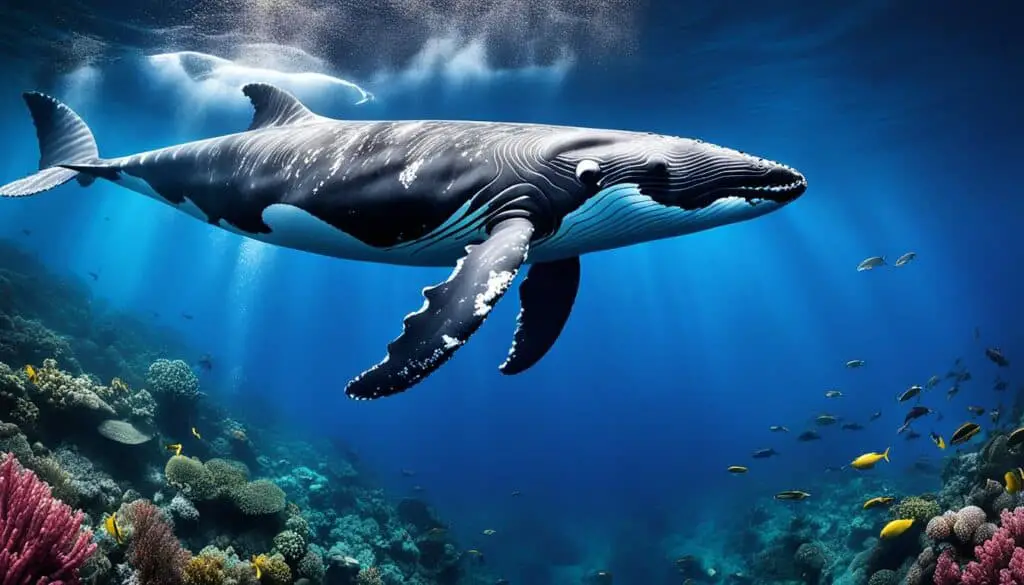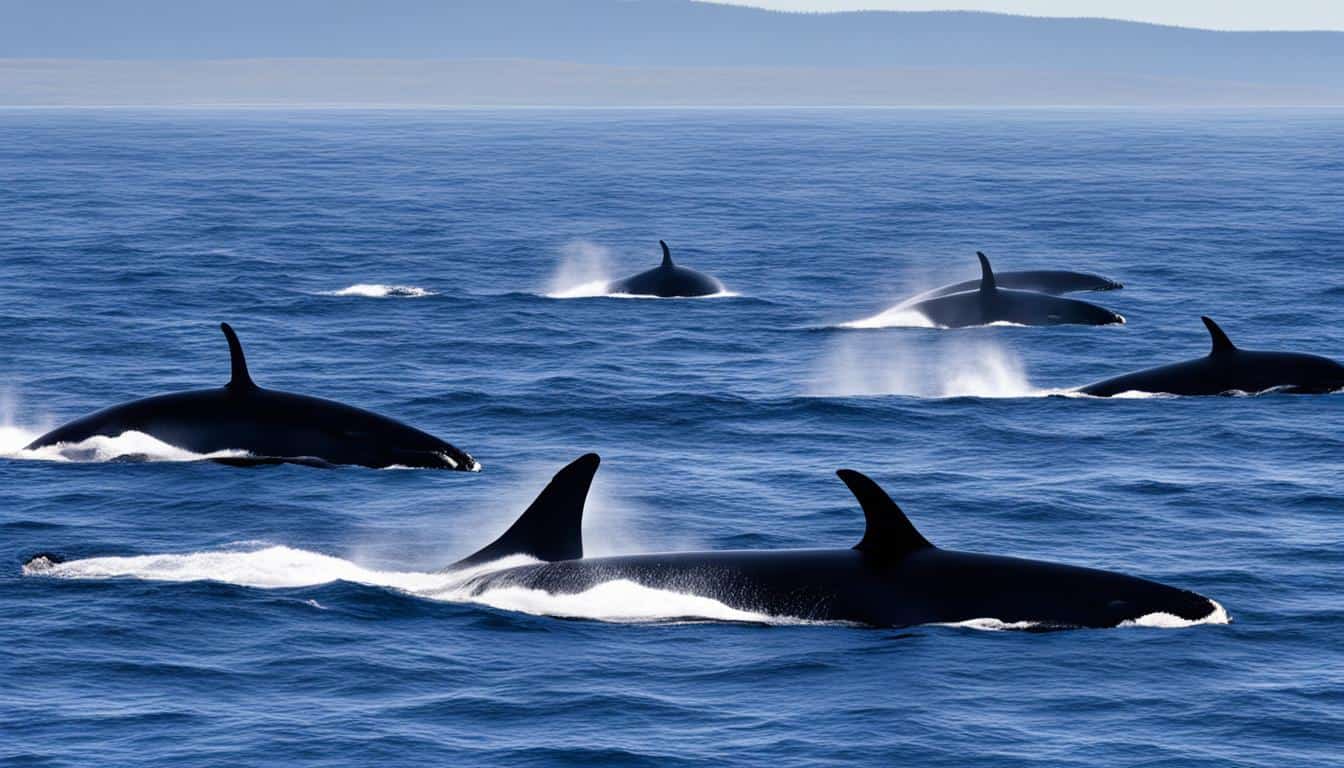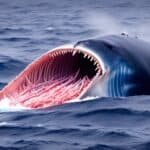Whales are among the most fascinating creatures on Earth, showing a wide range of diversity. This article will take you on a journey to discover the amazing types of whales in our oceans. Each type has special adaptations that help them survive. You’ll learn about their classification, roles in the ocean, and the challenges they face. This will show why whale diversity is crucial for the health of our marine ecosystems.
Understanding Whale Classification and Taxonomy
Whales show amazing diversity, divided into two main groups: baleen whales and toothed whales. Knowing about these groups helps us see the wide range in the cetacean family. We’ll look at the key differences between them and the latest in whale taxonomy.
Types of Whales: Baleen vs. Toothed
Baleen whales (Mysticeti) use baleen plates to filter food from the water. They eat small things like krill and plankton. The blue whale and humpback whale are examples of these whales.
Toothed whales (Odontoceti) have teeth and hunt bigger prey. They use echolocation to find and catch their food. Orcas and sperm whales are well-known toothed whales.
Whale Subcategories and Ecotypes
There are also subcategories and ecotypes within whales that show their genetic and ecological variety. For example, killer whales have different ecotypes like Resident and Bigg’s killer whales. These show clear differences in how they live, what they eat, and how they organize themselves, even if they look similar.
Recent Discoveries in Whale Taxonomy
New genetic studies have greatly improved our knowledge of whale classification. Ongoing research keeps revealing more about the relationships within and between whale groups. These findings often change our current understanding of whale taxonomy, showing how science in marine biology is always evolving.
What are the different species of whales?
Whales are amazing creatures, with many species that differ in size, shape, and behavior. Learning about the different whales helps us understand marine life better. It shows us the special traits each whale has. We’ll look at some main whale types, their unique features, and their important role in the ocean.
Main Species Overview
Some whales are known for their amazing features and actions. Key whale kinds include:
- Blue Whale: The biggest animal on Earth, up to 100 feet long.
- Humpback Whale: Known for its songs and jumping out of the water.
- Orca (Killer Whale): Smart predators with complex social lives.
- Sperm Whale: Can dive very deep and has a huge head.
- Gray Whale: Makes long trips and has skin covered in barnacles.
Notable Characteristics of Each Species
Each whale has special traits that make it unique:
- Blue Whale: Its heart is as heavy as a small car, showing its huge size.
- Humpback Whale: Has special patterns on its tail that help identify it.
- Orca: Uses smart hunting methods and is known for its social life.
- Sperm Whale: Has the biggest brain of any animal, which helps its social behavior.
- Gray Whale: Makes one of the longest migrations, traveling thousands of miles yearly.
Importance of Whale Species in Ecosystems
Whales are more than just big animals. They are crucial to their ecosystems. They help with nutrient cycling and support many other marine species. By eating, they keep the balance in ocean food webs. Their waste helps plankton grow, which is key to the marine food chain.

The Amazing Size and Weight of Whales
Whales are known for their huge sizes, making them some of the biggest animals on Earth. Their size and weight amaze marine fans and help us understand how they live and survive.
Comparative Dimensions Across Whale Species
Whales come in all sizes, showing their amazing variety. The blue whale is the biggest, reaching up to 100 feet long. It can weigh over 200 tons, which is huge. On the other end, the dwarf sperm whale is only about 9 feet long.
This huge size difference shows how whales have adapted to their environments. It also shows their different roles in the ocean.
| Whale Species | Length (Feet) | Weight (Tons) |
|---|---|---|
| Blue Whale | 100 | 200+ |
| Humpback Whale | 50 | 40 |
| Sperm Whale | 60 | 45-60 |
| Dwarf Sperm Whale | 9 | 0.5 |
Remarkable Weight Variations Among Whale Types
Whales’ weights are key to their survival. Big whales like the blue and sperm whales need their size for deep dives and long trips. Their fat helps them stay warm in cold water.
Smaller whales can move fast, which helps them hunt and avoid danger. These size differences show how whales adapt to their homes in the ocean.
Diverse Diets and Feeding Techniques of Whales
Whales have many different diets and ways of eating that show their roles in the ocean. Each species has its own way of getting food, which puts them into two main groups: baleen and toothed whales. These feeding habits tell us a lot about how they live in the sea.
Baleen Whales and Their Filter Feeding
Baleen whales eat a lot of small sea creatures by using a special way called filter feeding. They have baleen plates in their mouths that act like a fine-mesh sieve. This lets them catch krill, plankton, and small fish without trouble. Baleen whales use two main ways to feed:
- Lunge feeding: They take in a big mouthful of water and food, then spit out the water but keep the food.
- Skim feeding: They swim on the surface with their mouths open to pick up food.
This way of eating helps them survive in places where there’s a lot of food in the ocean.
Toothed Whales: Apex Predators of the Ocean
Toothed whales hunt in a different way than baleen whales. These include orcas and sperm whales, which catch bigger fish, squid, and even seals. They have some special skills for hunting:
- Echolocation: They use sound waves to find their prey, even in dark water.
- Cooperative hunting: Some, like orcas, work together to catch their food.
The different diets of whales show how each one has adapted to its own part of the ocean. This helps keep the ocean’s balance.
| Whale Type | Feeding Technique | Prey Types |
|---|---|---|
| Baleen Whales | Filter Feeding | Plankton, Krill, Small Fish |
| Toothed Whales | Echolocation & Hunting | Fish, Squid, Marine Mammals |
Challenges Facing Whale Species Today
Today, whale species face many threats that put their survival at risk. Habitat destruction from coastal development and industrial activities is a big problem. Marine pollution, like plastic waste and toxic chemicals, makes their home dangerous and harms their health.
Climate change also affects them by changing water temperatures and reducing food. Entanglement in fishing gear is another big issue, often causing injury or death. These problems show how human actions, like commercial whaling and ship strikes, harm whales.
But, there are efforts to protect whales. For example, creating marine protected areas and controlling ship traffic in important habitats helps. These actions aim to lessen threats and highlight whales’ importance in keeping oceans healthy. You can help by supporting conservation groups and pushing for whale-friendly policies.
FAQ
What are the main types of whales?
Whales are divided into two main groups. Baleen whales (Mysticeti) use baleen plates to filter food. Toothed whales (Odontoceti) hunt using echolocation.
Can you provide examples of different whale species?
The blue whale is the biggest animal on Earth. The humpback whale is known for its songs. The orca, also called the killer whale, is highly intelligent.
Each species has its own unique traits and ways of adapting to the ocean.
How does whale size impact their survival?
A whale’s size is key to its survival. Large whales like the blue whale can be up to 100 feet long and weigh over 200 tons. This size helps them store energy and swim efficiently.
What are the feeding techniques used by baleen and toothed whales?
Baleen whales eat small sea creatures by filter feeding. They use techniques like lunge feeding and skim feeding. Toothed whales, like orcas and sperm whales, hunt with complex methods and echolocation to catch their food.
What are the primary threats facing whale species today?
Whales face many dangers, including habitat loss, pollution, climate change, and getting caught in fishing gear. Human actions like commercial whaling and ship strikes also harm them. Conservation efforts are needed to protect them.
Why is understanding whale diversity important?
Knowing about whale diversity helps us understand their role in the ocean. They play a big part in nutrient cycling. This knowledge helps us protect these amazing sea creatures.
Source Links
- https://www.fisheries.noaa.gov/feature-story/new-research-reveals-full-diversity-killer-whales-two-species-come-view-pacific-coast
- https://ocean.si.edu/ocean-life/marine-mammals/whales
- https://www.saveourblueocean.shop/post/from-the-tiniest-krill-to-the-mighty-blue-whale-exploring-marine-life-diversity







